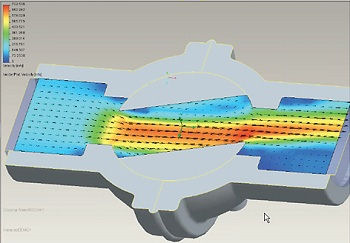Latest News
February 8, 2013
 |
Being a grand poobah in the technology for design and mechanical engineers milieu, I often forget that what is as plain as the gut hanging over my belt is not so obvious to others feverishly working on being the best engineer they can be. Today’s Check it Out white paper, “CFD for Mechanical Design Engineers: A Paradigm Shift for Better Design,” was a stick that whacked me out of that pompous fog.
Here’s a quote to show you what I mean: “When a large group of CATIA, Pro/ENGINEER ]PTC Creo], Inventor, and SolidWorks users were asked why they didn’t use CFD ]computational fluid dynamics], the most common responses were (1) ‘most mechanical design engineers don’t have the necessary expertise and knowledge to use a CFD code,’ and (2) ‘most mechanical engineers are not aware of what CFD can do for them.’”
This paper, written by CIMdata and made available to you by Mentor Graphics, whacks these two objections out of the ballpark clearly, succinctly, and thoroughly. And don’t you CFD doyens fret that this paper represents a threat to your position. It bolsters it while simultaneously advocating—very well—the case for early, often, and non-threatening CFD analysis by design engineers. See, when a design engineer’s model moves in the right direction before it gets to you, it means that you can be more effective in your work. It’s that simple.
This eight-page PDF has three main sections—the drivers and challenges that affect and influence the early CFD use within a PLM (product lifecycle management) environment, the benefits of early CFD use in design, and a discussion of how and what FloEFD CFD for MCAD engineers from Mentor Graphics means to designers—plus a recap. It’s all very well done, and not a word is wasted, as you might expect from CIMdata.
The first section gets right to the heart of the matter: You’re designing more and more complex products and you need to do it faster and less expensively. To compress design cycles, you’ve been running FE (finite element) and kinematic analyses for a while now. What this means for your process is that although you might have a design with good structural or motional integrity, models can arrive at the CFD specialist with “back to the drawing boards” design flaws. Analyzing two-thirds of what you need to know leaves you with a gaping hole in your process. Once again, it’s that simple.
The discussion then segues to the benefits of early CFD use. This is where the above quote came from. Essentially what we’re talking about here is faster design cycles, fewer prototypes, reduced rework, and improved end product quality. There are tips for you considering implementing early CFD in design such as “The process has to be well documented and must embody CFD best practices so that non-specialists can use CFD with confidence that the results are valid and appropriate.”
Next, FloEFD is introduced. Again, this is a thorough discussion. Best about it, however, is that it’s no baloney. It simply tells you that FloEFD is designed for CFD analyses executed by design and mechanical engineers. It covers the many kinds of CFD studies it supports, such as pressure drop in hydraulic and pneumatic devices, air flows around objects, coupled heat transfers, and electronics cooling. Its direct CAD interfaces are covered, and it lingers on how FloEFD guides the non-expert through a CFD analysis that accounts for the unfamiliarity of MCAD users with building a CFD analysis. This section is almost a spec sheet rendered in prose. CIMdata is anything but gushy.
The big point of this white paper is, perhaps, encapsulated in this quote: “When engineers and managers were asked what were the most important benefits to the company from early and frequent use of CFD by design engineers, they replied: reduce prototyping and testing costs (35%), improve product performance and functionality (22%), reduce design time (17%), and reduce risk of design mistakes (15%).”
Those seem plenty reason enough to check out this white paper. Hit the link over there and see for yourself.
Thanks, Pal. – Lockwood
Anthony J. Lockwood
Editor at Large, Desktop Engineering
CFD for Mechanical Design Engineers: A Paradigm Shift for Better Design
Subscribe to our FREE magazine, FREE email newsletters or both!
Latest News
About the Author
Anthony J. Lockwood is Digital Engineering’s founding editor. He is now retired. Contact him via [email protected].
Follow DE





